Cookinseln |
|
|
|
| Übersicht – Contents: | |
Cookinseln |
|
|
|
| Übersicht – Contents: | |
Flaggen – Flags: |
|
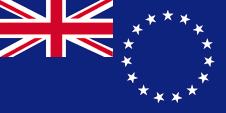 |
Nationalflagge – national flag, Seitenverhältnis – ratio = 1:2, Quelle/Source nach/by: Flags of the World |
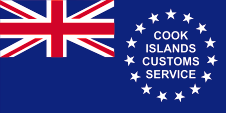 |
Zollflagge – customs flag, Seitenverhältnis – ratio = 1:2, Quelle/Source nach/by: Flags of the World |
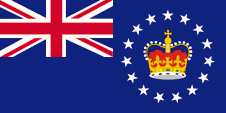 |
Flagge des Repräsentanten der britischen Krone – flag of the Representative of British Crown, Seitenverhältnis – ratio = 1:2, Quelle/Source nach/by: Flags of the World |
historische Flaggen – historical Flags: |
|
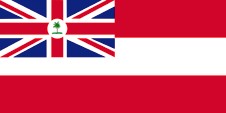 |
1893–1901, Nationalflagge – national flag, Seitenverhältnis – ratio = 1:2, Quelle/Source nach/by: Flags of the World |
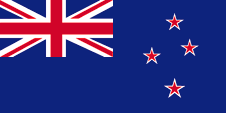 |
1901–1973, Nationalflagge von Neuseeland – national flag of New Zealand, Quelle/Source: Corel Draw 4 |
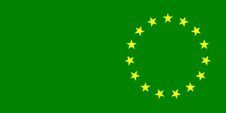 |
1973–1979, Nationalflagge – national flag, Seitenverhältnis – ratio = 1:2, Quelle/Source nach/by: Flags of the World |
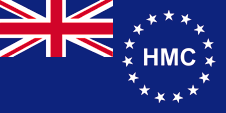 |
bis/to 2012, Zollflagge – customs flag, Seitenverhältnis – ratio = 1:2, Quelle/Source nach/by: Flags of the World |
Bedeutung/Ursprung der Flagge – Meaning/Origin of the Flag: |
|
| Da Neuseeland dem Ensign-System verbunden geblieben ist, führen auch die Cookinseln (ein mit Neuseeland assoziierter Staat) einen Blue Ensign, aber erst seit dem 04.01.1979. Die frühere Flagge, 1973 eingeführt, war nur grün mit dem Ring aus fünfzehn Sternen, wurde aber am 04.01.1979 im Zusammenhang mit einem Machtwechsel geändert. | As New Zealand stays
bound in the ensign-system, the Cook Islands (awith New Zealand associated state)
have a Blue Ensign, too, but not until 4th of January in 1979. The former flag, introduced in 1973, was only green with the ring from fifteen stars, and was changed on 4th of january 1979, in context with a change of government. |
| Die Nationalflagge der Cookinseln ist also ein sogenannter "Blue Ensign". Das ist ein ein dunkelblaues Flaggentuch mit einer Flaggendarstellung – dem britischen Union Jack – in der Oberecke. Der Union Jack weist auf die frühere koloniale Verbindung der Inseln zu Großbritannien hin. | The national flag of
the Cook Islands is so a so named "Blue Ensign". This is a dark blue flag cloth
with a flag depiction – the British Union Jack – in the upper staff quadrant. The Union Jack points to the former colonial connexions of the islands to United Kingdom. |
Großbritannien hatte
in Jahr 1864 ein Flaggensystem eingeführt, in dem:
Seit 1865 durften Schiffe von Kolonialregierungen einen Blue Ensign mit einem Badge (Abzeichen) im fliegenden Ende führen. Die jeweiligen Regierungen sollten entsprechene Bagdes zur Verfügung stellen. Handelsschiffe und seefahrende Privatpersonen aus Kolonien dürfen nur dann einen Red Ensign mit Badge führen, wenn von der britischen Admiralität eine entsprechende Erlaubnis für die Kolonie erteilt wurde. |
The
United Kingdom introduced a flag system in 1864 in which:
Since 1865 ships of colonial governments were permitted to fly the Blue Ensign with a badge in the flying end of the flag. The respective governments were asked to design appropriate badges. Merchant ships and seafaring persons from colonies were only permitted to use the Red Ensign with a badge, then also named Civil Ensign, if permission has been given to the respective colony by the British admiralty. |
| Die Cookinseln, seit 1965 mit eigener Verwaltung, verwenden kein Badge in diesem Sinne, sondern einen Kreis aus fünfzehn weißen Sternen, welche die Inseln des Archipels verkörpern. | The Cook Islands, since 1965 with their own government, do not use a badge in this meaning, but a circle from fifteen white stars, which represent the islands of the archipelago. |
| Die Insel Rarotonga hatte bereits 1850 eine eigene Flagge eingeführt, eine Flagge in den Farben Rot und Weiß, wie in Polynesien üblich. Sie zeigte drei horizontale Streifen in Rot, Weiß und Rot, mit drei blauen Sternen in der Mitte des weißen Streifens. Nach Errichtung des britischen Protektorats wurde die Union Jack in die Oberecke gesetzt. Im Jahre 1893, zwei Jahre nach Bildung der Föderation, wurde ein Badge mit einer Palme in die Mitte des Union Jack eingefügt, und die Flagge offiziell für die Cook Islands Federation übernommen. | The island of Rarotonga had introduced its own flag in 1850, a flag in the colors red and white, as usual in Polynesia. It showed three horizontal stripes in red, white and red, with three blue stars in the middle of the white stripe. After the establishment of the British Protectorate, the Union Jack was placed in the upper corner. In 1893, two years after the formation of the Federation, a badge with a palm tree in the middle of the Union Jack was inserted, and the flag became officially adopted for the Cook Islands Federation. |
| Ab dem Jahre 1901, als die Inseln endgültig an Neuseeland kamen, galt hier nur noch die Flagge Neuseelands, und zwar bis zum 23.07.1973, als eine erste eigene Flagge angenommen wurde. Sie war einfarbig grün, und zeigte im wehenden Ende einen Ring aus 15 goldenen Sternen. Jeder dieser Sterne stand für eine der Inseln des Landes. Nach einem politischen Machtwechsel wurde am 04.01.1979 die heutige Flagge eingeführt. | From the year 1901,
when the islands came to New Zealand finally, here was only to use the flag of New
Zealand, to the 23rd of July in 1973, as a first own flag was adopted. It was single-coloured green, and showed in the flying end a ring of 15 golden stars. Each of these stars stood for one of the islands of the country. After a political change of power was introduced the today's flag on 4th of January in 1979. |
| Quelle/Source: Die Welt der Flaggen, Flags of the World, Wikipedia (D) | |
Wappen – Coat of Arms: |
|
 |
Wappen der Cookinseln – coat of arms of the Cook Islands, Quelle/Source nach/by: Wikipedia (D) |
Bedeutung/Ursprung des Wappens – Meaning/Origin of the Coat of Arms: |
|
| Das Wappen der Cook-Inseln zeigt einen Schild in der Mitte. Die 15 Sterne darin entsprechen dem Bild auf der Flagge. Ein fliegender Fisch (Maroro) und eine weiße(?) Seeschwalbe (kakaia) sind auf jeder Seite des Schildes zu sehen. Sie stützen ein Kreuz als Symbol für das Christentum, und ein Paddel von Rarotonga (momore taringavaru) als Symbol für den Traditionsreichtum der Cook-Inseln. Redner halten es während traditioneller Diskurse in der Hand. Der Helm auf dem Schild ist ein "ariki", ein Kopfputz (pare kura) aus roten Federn, ein Symbol für die Bedeutung des traditionellen Rang-Systems. Der Name der Nation steht auf einem Banner unterhalb des Schilds. Das Wappen wurde von Papa Motu Kora, einem mataiapo (ein traditioneller Häuptlingstitel) aus dem Dorf Matavera auf Rarotonga entworfen. Papa Motu ist der Sekretär des Ariki-Hauses, das Haus der höchsten Häuptlinge der gesamten Cook-Inseln. Er hat diesen Posten seit vielen Jahren inne, und ist auf den Cook-Inseln auch als "tumu korero", oder traditioneller Redner bekannt. | The Coat of Arms of the
Cook Islands has a shield as its focal point The shield contains the fifteen stars found
on the national flag. A flying fish (maroro) and a White Tern (kakaia) are on each side of the shield, one supporting a cross as a symbol for Christianity, the other holding a Rarotongan club (momore taringavaru) as a symbol for the richness of Cook Islands' tradition. Orators used to hold it during traditional discourses. The helmet is an ariki head-dress (pare kura) of red feather, symbolising the importance of the traditional rank system. The name of the nation is on a banner below the shield. The coat of arms was designed by Papa Motu Kora, a mataiapo, a traditional chiefly title from the village of Matavera in Rarotonga. Papa Motu is the secretary of the House of Ariki -- the house of paramount chiefs from all over the Cook Islands. He has held this post for many years and is well known in the Cook Islands as a tumu korero or traditional orator. |
| Quelle/Source: Wikipedia (EN) | |
| Landkarten – Maps: |
Lage – Position: |
Landkarte
des Landes – Map of the Country: |
Zahlen und Fakten – Numbers and Facts: |
|
|
|
|
|
|
|
|
|
|
|
|
|
|
|
|
|
|
|
|
|
| Quelle/Source: Wikipedia (D), Volker Preuss, Länder der Erde | |
Geschichte: |
| 9. Jahrhundert
·
Besiedlung durch Polynesier 20.10.1595 · der spanische Seefahrer Alvaro de Mendaña de Neyra landet auf der Insel Pukapuka, und entdeckt somit die heutigen Cookinseln 1606 · der in spanischem Auftrag fahrende Seefahrer Pedro Fernández de Quirós landet auf Rakahanga 1722 · der niederländische Seefahrer Jakob Roggeveen durchführt auf seiner Weltumseglung den südlichen Archipel 1764 · britische Seefahrer erreichen Pukapuka, nennen es Danger Island 1773–1779 · der britische Seefahrer James Cook entdeckt am 23.09.1773 die Insel Manuae, und erreicht mehrfach den Roggeveen-Archipel 1789 · der britische Seefahrer William Bligh landet auf Aitutaki 1813 · Beginn der Kolonisierung durch Großbritannien, von Neuseeland und Australien aus 1877 · die Inseln werden Teil der Britischen Westpazifischen Territorien (bis 1901) 26.10.1888 · die Inseln werden offiziell britisches Protektorat 05.06.1891 · Bildung der Cook Islands Federation 07.10.1900 · die Inseln werden der Verwaltung Neuseelands unterstellt 11.06.1901 · die Inseln werden Neuseeland angeschlossen 04.08.1965 · Neuseeland gewährt Selbstverwaltung, bei Assoziierung mit Neuseeland und Anerkennung der britischen Monarchen als Staatsoberhaupt, Neuseeland übernimmt Außenpolitik und Verteidigung 1991 · Freundschaftsvertrag mit Frankreich über Handel, Wirtschaft und militärischen Schutz |
History: |
| 9th century
· colonization by Polynesians 20th of October in 1595 · the Spanish seafarer Alvaro de Mendana de Neyra lands on the island of Pukapuka, and thus he discoveres the today's Cook Islands 1606 · the in Spanish orders traveling seafarer Pedro Fernández de Quirós lands on Rakahanga 1722 · the Dutch seafarer Jacob Roggeveen comes the southern archipelago during his circumnavigation of the Earth 1764 · British sailors reach Pukapuka and name it Danger Island 1773–1779 · The British seafarer James Cook discoveres Manuae Island on 23rd of Sept. in 1773, and reaches several times the Roggeveen Archipelago 1789 · the British seafarer William Bligh lands on Aitutaki 1813 · start of the colonization by United Kingdom, from New Zealand and Australia 1877 · the islands become part of the British Western Pacific Territories (to 1901) 26th of October in 1888 · the islands become officially a British protectorate 5th of June 1891 · establish of the Cook Islands Federation 7th of October in 1900 · the islands become subordinated under the administration of New Zealand 11th of June in 1901 · the islands become annexed to New Zealand 4th of August in 1965 · New Zealand grants self-government in association with New Zealand under recognition of the British monarch as head of state, New Zealand takes over foreign policy and defense 1991 · friendship treaty with France about trade, economic and military protection |
| Quelle/Source: Wikipedia (D), World Statesmen |
Ursprung des Landesnamens – Origin of the Country's Name: |
|
| Als der britische Seefahrer James Cook am 23. September 1773 die Insel Manuae entdeckte, gab er ihr den Namen "Sandwich Island", zu Ehren von John Montagu, dem 4. Earl of Sandwich. Im Jahre 1778 änderte Cook den Namen in Hervey Island, zu Ehren des Ersten Lords der Admiralität, und übertrug den Namen Sandwich auf die Hawaii-Inseln. Inzwischen war klar geworden, dass die Insel Manuae viele Nachbarinseln hat (den Roggeveen-Archipel), und Cook fasste alle Inseln dieser Region unter dem Namen "Hervey-Inseln" zusammen. Der russische Seefahrer Admiral Adam Johann von Krusenstern der zwischen 1803 und 1806 die Welt umsegelte, benannte die Hervey-Inseln zu Ehren des berühmten britischen Seefahrers in "Cook-Inseln" um, und trug den Namen im Jahre 1824 – er war inzwischen Leiter des Seekadetten-Korps und Ehrenmitglied der Akademie der Wissenschaftenso – in seine Landkarten ein. Das hat sich durchgesetzt. | When the British
navigator James Cook on 23rd of September in 1773 discovered Manuae Island, he gave it the
name "Sandwich Island", in honor of John Montagu, the 4th Earl of Sandwich. Cook
in 1778 changed the name in Hervey Iceland, in honor of the First Lord of the Admiralty,
and the name Sandwich Islands becomes transfered to Hawaii. Meanwhile it became clear that
Manuae Island has many neighboring islands (the Roggeveen Archipelago), and Cook
summarized all the Islands in the region under the name of "Hervey Islands".
The Russian seafarer Admiral Adam Johann of Krusenstern, who made between 1803 and 1806 a world circumnavigation, renamed the Hervey Islands to "Cook Islands" in honor the famous British navigator. In 1824 he noted this name in his maps – Krusenstern was now head of the cadets corps and honorary member of the Academy of Science. This has prevailed. |
| Quelle/Source: Wikipedia (D), Volker Preuss | |